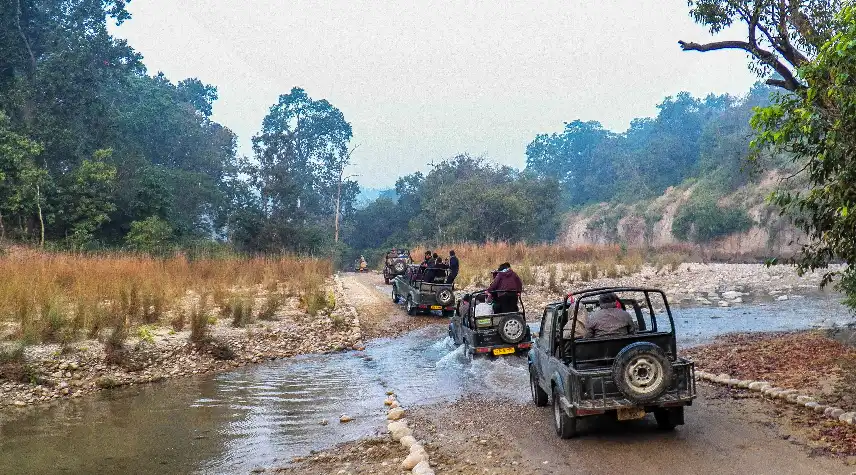
Jim Corbett National Park is not just about wildlife—it's a destination filled with scenic viewpoints, riverside retreats, heritage landmarks, and lush forest zones waiting to be explored. Spanning over 520 square kilometers, the park offers visitors a chance to experience its natural beauty and cultural charm through a variety of unique attractions and eco-tourism zones.
Jim Corbett National Park offers a diverse array of experiences beyond wildlife. From lush forests and scenic rivers to heritage sites and adventure zones, every visitor can find something memorable in the park's natural and cultural offerings.
One of the most popular and picturesque zones, Dhikala is known for its breathtaking landscapes and high chances of spotting tigers and elephants. It offers a panoramic view of the valley and the Ramganga River, and visitors can stay inside the forest lodge for a complete jungle experience.
Close to Ramnagar, Bijrani is ideal for day safaris and is known for its dense sal forests, open grasslands, and diverse wildlife. It’s a favorite among photographers and first-time visitors.
Open throughout the year, Jhirna is located in the southern part of the park and is known for frequent leopard and sloth bear sightings. The area is also rich in birdlife and scenic beauty.
A relatively new addition, Dhela offers beautiful landscapes with mixed forests and grasslands. It’s great for birdwatching and has a good population of herbivores and carnivores alike.
This zone is situated in the hilly terrain of the northeastern boundary and is ideal for bird enthusiasts. It features riverine forests and offers occasional sightings of leopards and elephants.
Located on a large rock in the middle of the Kosi River near Ramnagar, this sacred temple attracts pilgrims and tourists alike. It offers panoramic views of the river and surrounding hills.
The heritage bungalow of Jim Corbett, now converted into a museum, showcases his life, hunting equipment, letters, and photographs. It's an important stop for history and conservation enthusiasts.
Situated around 25 km from Ramnagar, this scenic waterfall is surrounded by dense teak forest. It is an ideal picnic spot and a peaceful retreat amidst nature.
The lifeline of Corbett, this river flows through the heart of the park and supports a variety of wildlife. Its banks are great for birdwatching, and visitors may spot crocodiles and gharials basking in the sun.
Flowing on the eastern periphery of the park, the Kosi River offers scenic views and is a popular site for riverside walks, birdwatching, and photography.
Located deep inside the park, this is the most sought-after rest house. Visitors enjoy a true jungle ambiance, close to elephants, deer, and even tigers.
Ideal for travelers seeking a quiet, eco-friendly experience. Situated along the Ramganga River, it offers peaceful surroundings and occasional animal sightings.
Popular with birdwatchers and wildlife lovers, this rest house is nestled along the Ramganga and offers a secluded retreat with beautiful jungle views.
Perfect for year-round travelers, these lodges are ideal for those exploring the southern zones of the park and offer excellent opportunities for wildlife photography.
A guided safari in an open vehicle that takes you deep into the park for a chance to witness tigers, elephants, and other wildlife. Available for those not staying inside Dhikala.
A unique way to explore the forest trails and spot wildlife up close. Though now restricted, some areas still offer this traditional jungle experience.
Guided treks in buffer zones and forest trails allow visitors to explore the Place to Visit in a quieter, more immersive way. Great for photographers and nature lovers.
Pleasant weather and high wildlife visibility make this the best time to visit. Migratory birds also arrive during this period.
Ideal for spotting tigers and elephants near water bodies. The grasslands turn golden, offering scenic beauty and better chances of animal encounters.
Most zones remain closed, but Jhirna and Dhela stay open. The forest becomes lush and green, and it's a great time for nature photography and enjoying solitude.
Make the most of your visit to Jim Corbett with these essential tips:
Advance Booking: Book safari permits and forest lodges in advance due to limited availability.
Professional Guides: Always opt for registered guides to enhance your experience and ensure safety.
Local Cuisine: Try Kumaoni food at local eateries near Ramnagar or in eco-resorts.
Respect Wildlife: Maintain silence during safaris, avoid littering, and follow park rules.
Binoculars & Cameras: Carry essentials for birdwatching and photography—Corbett is a paradise for lens lovers!
A visit to Jim Corbett National Park offers much more than wildlife safaris. With scenic landscapes, rich cultural sites, tranquil rivers, and adventure activities, it's a perfect destination for nature lovers, families, and thrill-seekers alike. Every corner of this park invites exploration, reflection, and appreciation of nature's grandeur.